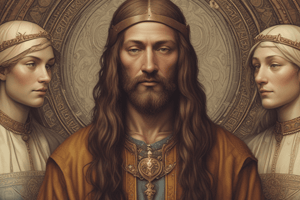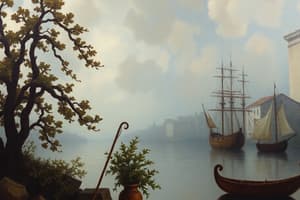Podcast
Questions and Answers
Which philosophical tenet, emphasizing human potential and achievement, was central to the Renaissance?
Which philosophical tenet, emphasizing human potential and achievement, was central to the Renaissance?
- Humanism (correct)
- Rationalism
- Existentialism
- Scholasticism
The Renaissance exclusively focused on religious themes, with secularism playing a negligible role.
The Renaissance exclusively focused on religious themes, with secularism playing a negligible role.
False (B)
Name three key artistic innovations that characterized Renaissance art, distinguishing it from preceding periods.
Name three key artistic innovations that characterized Renaissance art, distinguishing it from preceding periods.
Perspective, realism, human anatomy
__________, an Italian city-state, is widely regarded as the birthplace of the Renaissance due to its significant contributions to art and banking.
__________, an Italian city-state, is widely regarded as the birthplace of the Renaissance due to its significant contributions to art and banking.
Match the following Renaissance figures with their most notable contributions:
Match the following Renaissance figures with their most notable contributions:
Which factor did not significantly contribute to the rise of the Renaissance in Italy?
Which factor did not significantly contribute to the rise of the Renaissance in Italy?
The Northern Renaissance shared identical characteristics with the Italian Renaissance, with no significant regional variations.
The Northern Renaissance shared identical characteristics with the Italian Renaissance, with no significant regional variations.
Identify three major consequences of the Renaissance that shaped subsequent cultural and intellectual developments in Europe.
Identify three major consequences of the Renaissance that shaped subsequent cultural and intellectual developments in Europe.
__________ was a political philosopher who authored The Prince, a treatise on political strategy and leadership.
__________ was a political philosopher who authored The Prince, a treatise on political strategy and leadership.
Match the following scientific and technological advancements with their respective figures during the Renaissance:
Match the following scientific and technological advancements with their respective figures during the Renaissance:
Which of the following best describes the role of patronage during the Renaissance?
Which of the following best describes the role of patronage during the Renaissance?
The decline of feudalism had little to no impact on the rise of the Renaissance in Italy.
The decline of feudalism had little to no impact on the rise of the Renaissance in Italy.
Explain how the rediscovery of classical texts influenced Renaissance art, literature, and philosophy.
Explain how the rediscovery of classical texts influenced Renaissance art, literature, and philosophy.
The __________ Reformation, a major religious movement, began during the Northern Renaissance and challenged the authority of the Catholic Church.
The __________ Reformation, a major religious movement, began during the Northern Renaissance and challenged the authority of the Catholic Church.
Match the following characteristics with the respective Renaissance period:
Match the following characteristics with the respective Renaissance period:
Which of the following was a major cause of the decline of the Renaissance in the late 16th century?
Which of the following was a major cause of the decline of the Renaissance in the late 16th century?
Increased secularism during the Renaissance led to a complete abandonment of religious themes in art and literature.
Increased secularism during the Renaissance led to a complete abandonment of religious themes in art and literature.
Describe the impact of the printing press on the spread of knowledge and ideas during the Renaissance.
Describe the impact of the printing press on the spread of knowledge and ideas during the Renaissance.
__________ was a Dutch philosopher and theologian known for his contributions to humanism and his advocacy for religious tolerance.
__________ was a Dutch philosopher and theologian known for his contributions to humanism and his advocacy for religious tolerance.
Match the following Italian city-states with their respective characteristics:
Match the following Italian city-states with their respective characteristics:
Flashcards
What was the Renaissance?
What was the Renaissance?
Transition period in European history from the Middle Ages to modernity (14th-17th centuries) marked by a revival of classical art and literature.
What is Humanism?
What is Humanism?
Philosophical stance emphasizing human potential and achievement; a central tenet of the Renaissance.
What is Realism?
What is Realism?
Representation of subjects in a lifelike manner in art and literature; became a key focus in Renaissance art.
What is Perspective?
What is Perspective?
Signup and view all the flashcards
What is Florence?
What is Florence?
Signup and view all the flashcards
What is Patronage?
What is Patronage?
Signup and view all the flashcards
What is Individualism?
What is Individualism?
Signup and view all the flashcards
What is Secularism?
What is Secularism?
Signup and view all the flashcards
Who was Leonardo da Vinci?
Who was Leonardo da Vinci?
Signup and view all the flashcards
Who was Michelangelo?
Who was Michelangelo?
Signup and view all the flashcards
Who was Raphael?
Who was Raphael?
Signup and view all the flashcards
Who was Petrarch?
Who was Petrarch?
Signup and view all the flashcards
Who was Niccolò Machiavelli?
Who was Niccolò Machiavelli?
Signup and view all the flashcards
Who was William Shakespeare?
Who was William Shakespeare?
Signup and view all the flashcards
Who was Nicolaus Copernicus?
Who was Nicolaus Copernicus?
Signup and view all the flashcards
What was the Northern Renaissance?
What was the Northern Renaissance?
Signup and view all the flashcards
Who was Erasmus?
Who was Erasmus?
Signup and view all the flashcards
How did increased trade affect the Renaissance?
How did increased trade affect the Renaissance?
Signup and view all the flashcards
What are consequences of the Renaissance?
What are consequences of the Renaissance?
Signup and view all the flashcards
What led to the decline of the Renaissance?
What led to the decline of the Renaissance?
Signup and view all the flashcards
Study Notes
- The Renaissance was a period marking Europe's transition from the Middle Ages to modernity.
- Spanning the 14th to 17th centuries, it saw a resurgence of interest in classical art and literature.
Origins and Development
- The Renaissance originated in Italy during the Late Middle Ages before spreading to the rest of Europe.
- Florence is widely regarded as the Renaissance's birthplace.
- Contributing factors include the rediscovery of classical texts, increased wealth and patronage, new artistic and intellectual techniques, and political changes.
- The Italian Renaissance (14th-15th centuries) emphasized classical antiquity, humanism, and artistic innovation.
- The Northern Renaissance (15th-17th centuries) integrated classical ideas with local traditions, with a focus on religious reform and vernacular literature.
Key Characteristics
- Humanism, emphasizing human potential and achievement, was central.
- A renewed interest in classical Greek and Roman culture influenced art, literature, and architecture.
- Art saw advances like perspective, realism, and new mediums like oil paint.
- Scientific inquiry and observation grew, challenging traditional beliefs.
- Secularism increased, shifting focus from religious to worldly matters.
- Emphasis on individualism and personal expression became prominent.
Art and Architecture
- Renaissance art focused on realism, human anatomy, and perspective.
- Key artists include Leonardo da Vinci, Michelangelo, Raphael, and Donatello.
- Renaissance architecture revived classical elements like columns, domes, and symmetry.
Literature
- Renaissance literature explored humanistic themes and individual experiences.
- Influential writers include Petrarch, Machiavelli, and Shakespeare.
- The printing press facilitated the spread of knowledge and literature.
Science and Technology
- Significant advances occurred in science and technology during the Renaissance.
- Nicolaus Copernicus proposed the heliocentric theory.
- Galileo Galilei made important contributions to astronomy and physics.
- Medicine, anatomy, and engineering saw advances.
Philosophy
- Renaissance philosophy emphasized humanism, individualism, and reason.
- Key philosophers include Niccolò Machiavelli, Thomas More, and Erasmus.
- Thinkers explored political theory, ethics, and social reform.
Impact and Legacy
- The Renaissance marked a shift from medieval to modern thought.
- It fostered artistic, scientific, and intellectual innovation.
- The Renaissance influenced subsequent cultural and intellectual movements.
- It laid the groundwork for the Scientific Revolution and the Enlightenment.
- Emphasis on education, humanism, and individualism continues to shape modern society.
- Rediscovery of classical texts and ideas spurred intellectual growth.
- The patronage system supported artists and scholars, leading to creative achievements.
- Exploration and colonization expanded European horizons.
- The rise of powerful city-states in Italy contributed to economic and cultural development.
Notable Figures
- Leonardo da Vinci: Artist, scientist, and inventor known for works like the Mona Lisa and The Last Supper.
- Michelangelo: Artist and sculptor famous for sculptures like David and the Sistine Chapel ceiling.
- Raphael: Painter known for works such as The School of Athens.
- Donatello: Sculptor known for influential bronze and marble sculptures.
- Petrarch: Writer and poet considered the "father of Humanism."
- Niccolò Machiavelli: Political philosopher who wrote The Prince.
- William Shakespeare: English playwright and poet.
- Nicolaus Copernicus: Astronomer who developed the heliocentric theory.
- Galileo Galilei: Astronomer and physicist who made important scientific discoveries.
- Thomas More: English lawyer, social philosopher, and author.
- Erasmus: Dutch philosopher and theologian.
Key Concepts
- Humanism: Philosophical stance emphasizing human potential and achievement.
- Realism: Representation of subjects in a lifelike manner in art and literature.
- Perspective: Technique used in art to create the illusion of depth.
- Patronage: Support and financial backing provided to artists and intellectuals.
- Individualism: Emphasis on personal expression and self-reliance.
- Secularism: Focus on worldly matters rather than religious concerns.
Northern Renaissance
- The Northern Renaissance occurred in Europe north of the Alps, beginning around the 15th century.
- It blended classical ideas with local traditions.
- Key characteristics include a greater emphasis on religious reform and moral improvement, a focus on realism and detail in art, a strong tradition of vernacular literature, and the development of the printing press.
- Notable figures include Jan van Eyck, Albrecht Dürer, Erasmus, and Thomas More.
- The Northern Renaissance influenced the Protestant Reformation and the development of nation-states.
- Patrons included monarchs, nobles, and wealthy merchants.
Italian Renaissance City-States
- Several Italian city-states played a crucial role in the Renaissance.
- Florence was the birthplace of the Renaissance, known for its art and banking.
- Venice was a major maritime power and center of trade.
- Rome was the center of the Catholic Church and a major patron of the arts.
- Milan was a powerful duchy with a thriving economy.
- These city-states fostered competition and innovation in art, politics, and culture.
- The Medici family in Florence were significant patrons of the arts.
Causes of the Renaissance
- Economic growth and prosperity in Italian city-states.
- Rediscovery of classical texts and knowledge.
- Decline of feudalism and the rise of nation-states.
- Increased trade and cultural exchange.
- Development of universities and centers of learning.
- Patronage of the arts by wealthy merchants and rulers.
Consequences of the Renaissance
- Shift from medieval to modern thought.
- Development of new artistic and literary styles.
- Advances in science, technology, and exploration.
- Rise of humanism and individualism.
- Protestant Reformation and religious change.
- Spread of knowledge through the printing press.
- Increased secularism and focus on worldly matters.
- Rise of nation-states and political change.
Decline of the Renaissance
- The Renaissance began to decline in the late 16th century.
- Factors contributing to the decline include religious conflicts and the Reformation, economic crises and wars, centralization of power in nation-states, and the rise of new artistic and intellectual movements like Mannerism and the Baroque.
- The Renaissance legacy continued to influence subsequent cultural developments.
Studying That Suits You
Use AI to generate personalized quizzes and flashcards to suit your learning preferences.




